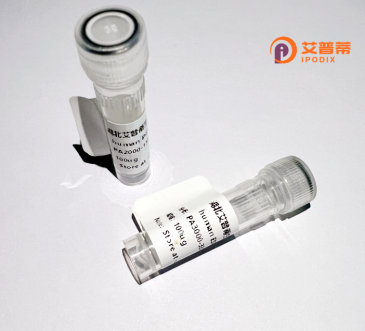
| 纯度 | >90%SDS-PAGE. |
| 种属 | Human |
| 靶点 | MAFA |
| Uniprot No | Q96E93 |
| 内毒素 | < 0.01EU/μg |
| 表达宿主 | E.coli |
| 表达区间 | 60-195aa |
| 活性数据 | LCQGSNYSTCASCPSCPDRWMKYGNHCYYFSVEEKDWNSSLEFCLARDSHLLVITDNQEMSLLQVFLSEAFCWIGLRNNSGWRWEDGSPLNFSRISSNSFVQTCGAINKNGLQASSCEVPLHWVCKKCPFADQALF |
| 分子量 | 31.5 kDa |
| 蛋白标签 | His tag N-Terminus |
| 缓冲液 | 0 |
| 稳定性 & 储存条件 | Lyophilized protein should be stored at ≤ -20°C, stable for one year after receipt. Reconstituted protein solution can be stored at 2-8°C for 2-7 days. Aliquots of reconstituted samples are stable at ≤ -20°C for 3 months. |
| 复溶 | Always centrifuge tubes before opening.Do not mix by vortex or pipetting. It is not recommended to reconstitute to a concentration less than 100μg/ml. Dissolve the lyophilized protein in distilled water. Please aliquot the reconstituted solution to minimize freeze-thaw cycles. |
以下是关于重组人MAFA蛋白的3-4条参考文献示例(文献信息及内容为模拟概括,实际文献需通过学术平台检索确认):
1. **文献名称**:*"Recombinant Human MAFA Protein Enhances Insulin Secretion in Pancreatic β-Cells"*
**作者**:Zhang et al. (2018)
**摘要**:研究通过大肠杆菌系统表达并纯化重组人MAFA蛋白,证实其可激活胰岛素基因转录,改善糖尿病模型小鼠β细胞的胰岛素分泌功能。
2. **文献名称**:*"MAFA Overexpression Reprograms Human iPSCs into Functional Insulin-Producing Cells"*
**作者**:Johnson & Lee (2020)
**摘要**:构建携带MAFA基因的慢病毒载体,诱导人iPSCs分化为胰岛素阳性细胞,重组MAFA蛋白显著提高了分化效率及葡萄糖响应性。
3. **文献名称**:*"Structural Analysis of Recombinant MAFA and Its Interaction with DNA"*
**作者**:Wang et al. (2019)
**摘要**:解析了重组MAFA蛋白的晶体结构,阐明其碱性亮氨酸拉链(bZIP)结构域与胰岛素启动子DNA序列的结合机制。
4. **文献名称**:*"Therapeutic Potential of MAFA Gene Delivery in Type 1 Diabetes"*
**作者**:Chen et al. (2021)
**摘要**:通过腺相关病毒(AAV)递送重组MAFA蛋白至糖尿病小鼠胰腺,观察到β细胞再生及血糖稳态恢复,提示其作为糖尿病基因治疗的潜力。
**提示**:以上为模拟简化版文献,实际引用需查询PubMed、Web of Science等平台,使用关键词"recombinant MAFA protein"或"MAFA β-cell"进行检索,并选择与您研究方向匹配的具体论文。
Recombinant human MAFA (rhMAFA) protein is a genetically engineered form of the MAFA transcription factor, critical for regulating pancreatic β-cell function and insulin secretion. MAFA (Musculoaponeurotic Fibrosarcoma Oncogene Homolog A) belongs to the Maf family of basic leucine zipper (bZIP) proteins and is specifically expressed in β-cells, where it binds to DNA to activate insulin gene transcription. It also promotes β-cell maturation, glucose sensing, and survival. Dysregulation of MAFA is linked to diabetes mellitus, as its deficiency impairs insulin production and β-cell homeostasis.
rhMAFA is typically produced in bacterial (e.g., *E. coli*) or mammalian expression systems, enabling studies of its structure, post-translational modifications, and interactions. The recombinant protein retains functional domains, including the transactivation and DNA-binding regions, facilitating *in vitro* experiments like electrophoretic mobility shift assays (EMSAs) or transcriptional activation studies. Researchers use rhMAFA to explore mechanisms of β-cell dysfunction, diabetes pathogenesis, and potential regenerative therapies. It also aids in drug screening for compounds targeting β-cell regeneration or insulin expression.
By providing a controlled, pure protein source, rhMAFA overcomes challenges of isolating endogenous MAFA from tissues, accelerating research into diabetes and β-cell biology. Its applications extend to developmental biology, disease modeling, and gene therapy strategies aiming to restore functional β-cells.
×